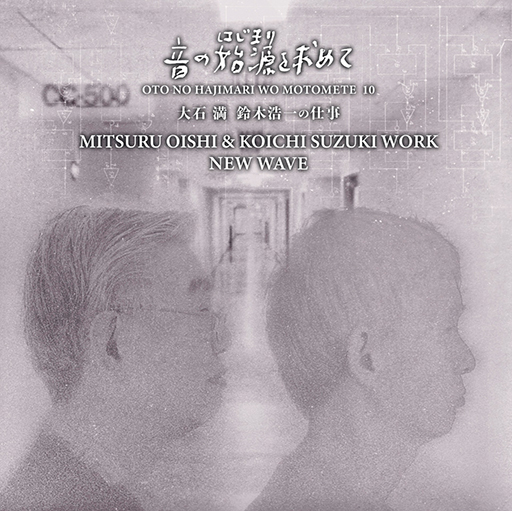
音の始源を求めて 10
大石 満 鈴木浩一の仕事
NEW WAVE
The Beginnings of
Japanese Electroacoustic Vol.10
MITSURU OHISHI & KOUICHI SUZUKI WORK
NEW WAVE
- 《東京湾》 近藤 譲 1987年
“Tokyo Bay” JO KONDO 1987 - 《マーマレード回路》 吉松 隆 1984年
“Marmalade Circuit” TAKASHI YOSHIMATSU 1984 - 《風の歌》 助川 敏弥 1980年
“Chant du Vent” TOSHIYA SUKEGAWA 1980 - 《コスモス200》 坪能 克裕 1984年
“Cosmos200” KATSUHIRO TSUBONOU 1984 - 《リヴァラン》 近藤 譲 1977年
“Riverrun” JO KONDO 1977
内容紹介
- 1.「東京湾」近藤 譲 (1987)
- この曲は器楽曲を電子音楽にリアリゼージョンした作品。原曲は「ノン・プロジェクション」というピアノ2台とオーケストラの曲。この頃は既にPCの時代に入っていて、PCの方が普通の意味で綺麗な音を作ることが出来たが、電子音楽はテープで聴くしかない音楽だから、何らかの音の力が欲しい。艶やかで磨かれた音はどうしてもつまらない、汚れていても力が感じられる音を作りたいと考えた。
- 2.「マーマレード回路」吉松 隆 (1984)
- 子供(少女)の声…を使った「こどもによる」テープ音楽。シュトックハウゼンの「少年の歌」へのオマージュ。電子音楽スタジオそのものを、変な音を作る「回路」に見立てた。素材は女の子3人の声。曲の途中では、「ぷるん」を8チャンネル合成してケチャにしたりした。
- 3.「風の歌」助川 敏弥 (1980)
- 作者の故郷の風土的な発想から荒涼とした原風景を表している。奥行きのあるホワイトノイズと正弦波を使った作品。製作時、NHK電子音楽スタジオにはキーボードがなかったのでフェーダー一つ一つに音階の音を入れて、フェーダーを上げ下げして旋律を作った。
- 4.「コスモス200」坪能 克裕 (1984)
- 天体の星(パルサー)たちが発するパルスをそのまま活かした作品。銀河系でパルサーがどの位置から、どのくらいの周期でパルスを発するかというデータを音に置き替えてた。電子も自然の産物だから、耳を開くとそこに感情は生まれて来て、天体からのメッセージと交流することができる。
- 5.「リヴァラン」近藤 譲 (1977)
- ピッチがはっきりしない鐘のような電子音で基音を作り。下方倍音を付け加える。そして、一つの音程に対して長短、強弱4種類くらい音を作り、楽譜に従ってテープの切り貼りをする。指定されたテンポに合わせて四分音符は何センチとテープの長さを当てはめて編集。しかし、テープの切り貼りで精密なリズムを作る至難を極めつつ、複数のテープを同時に再生しながら音を合成。この曲は純粋の電子音楽、つまり視覚的要素が何もない曲だから空間性に気を割きながら制作された。
Introduction
- 1. “Tokyo Bay” JO KONDO (1987)
- This piece is a rearrangement of an instrumental piece into electronic music. The original piece was called "Non Projection," a piece for two pianos and orchestra. At that time, we were already in the age of PCs, though PCs were able to create beautiful sounds in the usual sense, Electronic music can only be heard on tape. In this case I want some kind of sonic power. A glossy, polished sound is inevitably boring, and I wanted to create a sound that was dirty but still had a sense of power.
- 2. “Marmalade Circuit” TAKASHI YOSHIMATSU (1984)
- Tape music "by children" using children's (girls') voices.... It is an homage to Stockhausen's "Gesang der Jünglinge". The electronic music studio itself was used as a "circuit" to create strange sounds. The material is the voices of three girls. In the middle of the song, this matrial is "shaken" and synthesized into 8 channels before being transformed into a kecak.
- 3. “Chant du Vent” TOSHIYA SUKEGAWA (1980)
- It represents a desolate original landscape based on the artist's hometown's endemic ideas. A work using white noise and sine waves with depth. At the time of production, the NHK Electronic Music Studio did not have keyboard, so I created the melody by putting the notes of the scale in each fader and raising and lowering the faders.
- 4. “Cosmos200” KATSUHIRO TSUBONOU (1984)
- This work utilizes the pulses emitted by celestial stars (pulsars) as they are. The data of where pulsars are located in the galaxy and at what periodicity they emit their pulses were replaced with sounds. Since electrons are also a product of nature, when we open our ears, emotions emerge, and we can interact with messages from celestial bodies.
- 5. “Riverrun” JO KONDO (1977)
- A base note is created with a bell-like electronic sound of indistinct pitch. I added lower overtones. Then, for each pitch, I created about four different notes of different lengths, strengths, and weaknesses. The tape is then cut and pasted according to the score. The length of the tape is edited to match the specified tempo, with quarter notes given in centimeters. However, while mastering the extreme difficulty of creating a precise rhythm by cutting and pasting tapes, I synthesized the sounds while playing back multiple tapes simultaneously. Since this piece is purely electronic music, that is, there are no visual elements to refer to, it has been created while paying attention to spatiality.
BUY
- Official Online Shop
- https://sound3.buyshop.jp/items/72764961
- Amazon
- https://amzn.asia/d/gojWL7G
- CDに関するお問い合わせ
- denshi-ongaku@sound3.co.jp
Manufacture Distribute by Sound 3 Co., Ltd. (P)2023
制作/有限会社 サウンドスリー
企画/大阪芸術大学音楽工学OB有志の会
Sound 3 Co., Ltd.
#404 Style House Ebisu 3-34-14 Ebisu Shibuya-ku Tokyo Japan zip 150-0013